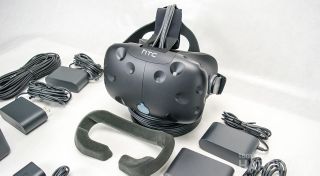HTC's Using Intel's WiGig For A Wireless Vive Accessory

HTC's doing a little Spring cleaning, and it's starting with all the wires protruding from its headsets. The company announced today at Computex 2017 that it has partnered with Intel to create a "wireless VR accessory" for the Vive HMD. That accessory will rely on WiGig, the wireless tech Intel created to let you connect basically everything to your PC without having to plug in a single wire, and is expected to work with existing Vive HMDs.
First a quick flashback. Not too far back--just to Google's I/O developer conference, where HTC announced that it created a standalone headset for the new-and-improved Daydream VR platform. That headset (and others like it) will use Qualcomm's Snapdragon 835 VR platform to offer XR experiences without requiring people to own high-end PCs or connect their headsets to another device. Everything happens right on the headset.
Of course, those headsets are going to be less powerful than the current Vive and other PC-based VR systems like the Oculus Rift. Today's announcement showed that HTC wants to offer a similar, but not identical, experience for desktop users. This accessory won't result in a self-contained headset; you'll still have to connect your Vive to a relatively powerful PC. But at least you won't have to deal with a bunch of wires.
This is how HTC described the accessory in its announcement:
The WiGig technology, based on 802.11ad standard, works solely in the interference- free 60GHz band, and enables high throughput and low latency in both directions, from the PC to HMD and from HMD to PC. This means pristine video quality with <7ms latency in any environment, supporting multiple users sharing the same space. All of this results in the seamless wireless VR with the Vive!
The extent to which the wireless VR is "seamless" depends on how much lower than 7ms latency HTC manages to get. Low latency is crucial to XR--too much can hurt your sense of immersion at best and make you feel sick at worst. The good news is we might not have to wait long to find out how well this accessory works: HTC said it's going to show off a proof of concept when it heads to E3 from June 13-15.
In the meantime, we can take comfort in knowing HTC isn't the only company that's chasing that wireless VR dream. AMD acquired an Austin startup called Nitero for its wireless XR technology in April, and we recently went hands-on with Sixa's Rivvr wireless VR system. Oh, and Oculus is also working on a self-contained, untethered HMD with Project Santa Cruz. Hopefully we can bid adieu to all these wires sooner than later.
Stay on the Cutting Edge
Join the experts who read Tom's Hardware for the inside track on enthusiast PC tech news — and have for over 25 years. We'll send breaking news and in-depth reviews of CPUs, GPUs, AI, maker hardware and more straight to your inbox.

Nathaniel Mott is a freelance news and features writer for Tom's Hardware US, covering breaking news, security, and the silliest aspects of the tech industry.
-
Jeff Fx People are already using the TPCast wireless solution for the Vive. The downside is that TPCast does not support the microphone, so you need a separate Bluetooth mic for multiplayer and co-op.Reply -
dstarr3 Well, assuming the HMD is showing 90fps, a 7ms latency is less than one frame, so theoretically, it should be fine. But is it 7ms to just send the information wirelessly, or is it 7ms to compress, send, and then decompress that information?Reply
It makes me wonder about some sort of non-uniform compression algorithm, they way nVidia's recent technology works that lowers the render quality of games around the periphery to save rendering power. If someone can devise a way to more highly compress video around the player's periphery where they can't so accurately see fine detail anyway, and preserve a less lossy compression for the player's center of vision, that would be a very good compromise.
Most Popular






